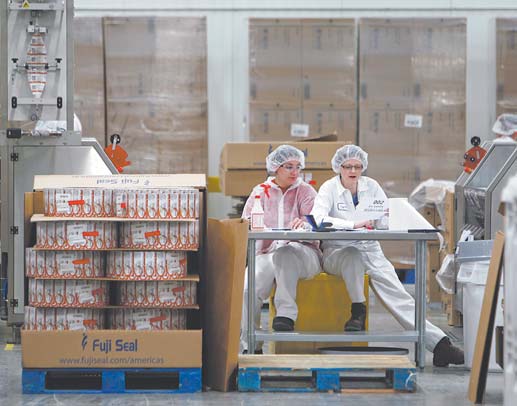Booming business

Two employees work in the sleeving plant where labels are put on containers at Chobani Greek Yogurt in South Edmeston, N.Y. Greek yogurt accounts for a quarter of the total yogurt market after a dizzying growth spurt.
Greek yogurt has a massive growth spurt
Associated Press
SOUTH EDMESTON, N.Y.
Chobani is making Greek yogurt as fast as Americans are eating it.
Its plant here in upstate New York farm country already pumps out 1.5 million cases of the thick yogurt every week, and pallets are stacked four stories high in the chilled warehouse.
But like other Greek yogurt makers, Chobani is expanding.
Greek yogurt accounts for a quarter of the total yogurt market after a dizzying growth spurt that is especially apparent in upstate New York. The nation’s No. 1 and No. 2 Greek yogurt brands — Chobani and Fage, respectively — are expanding plants within 60 miles of each other, and another company is building a plant in western New York. The expansions come as the big U.S. yogurt makers are focusing on Greek products, too.
Greek yogurt is made a bit differently than the thinner, more watery product that dominated U.S. supermarket shelves for decades. The whey is strained off, leaving a creamier yogurt high in protein and low in fat.
Though the quick growth has some hallmarks of a food fad — think cupcakes or bubble tea — the long-term investments point to a widespread industry belief that many Americans will continue to like their yogurt a bit richer.
“I personally do not believe that the yogurt story has started yet. I believe the yogurt story in this country is about to start,” Chobani’s founder, Hamdi Ulukaya, said during an interview in his office. “The magnitude hasn’t started yet.”
Ulukaya has harnessed the Greek yogurt boom more successfully than anyone.
In 2005, he bought an old Kraft Foods plant southeast of Syracuse with plans to make the kind of yogurt common in his home country of Turkey.
He believed the standard yogurt found on many supermarket shelves “wasn’t made right.”
His company, Agro- Farma, started by making yogurt for Stonyfield Farm and other companies before launching Chobani in 2007 with limited runs to stores in the New York City area.
The Chobani plant today bustles with 14 production lines mechanically squirting yogurt into plastic cups that zip down conveyor belts.
The company said production will increase from 1.5 million cases a week to more than 2 million when the current $134 million expansion is completed this year.
 43
43
